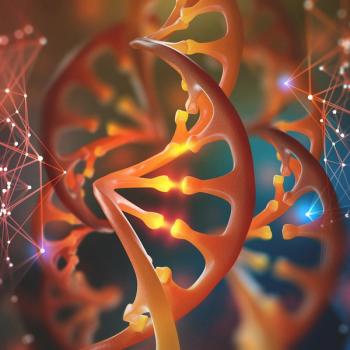
Five-Fraction Palliative Radiotherapy May Improve NSCLC Survival
SAN FRANCISCO-Patients with inoperable non-small-cell lung cancer (NSCLC) who receive 20 Gy of radiation therapy in five fractions achieved slightly superior palliation of thoracic symptoms than those receiving a single 10-Gy dose, according to a study presented at the 43rd Annual Meeting of the American Society for Therapeutic Radiology and Oncology (abstract 30). An unexpected finding was that patients receiving the five-fraction therapy survived significantly longer, the study authors said.
SAN FRANCISCOPatients with inoperable non-small-cell lung cancer (NSCLC) who receive 20 Gy of radiation therapy in five fractions achieved slightly superior palliation of thoracic symptoms than those receiving a single 10-Gy dose, according to a study presented at the 43rd Annual Meeting of the American Society for Therapeutic Radiology and Oncology (abstract 30). An unexpected finding was that patients receiving the five-fraction therapy survived significantly longer, the study authors said.
"There was a significant difference in survival between those receiving single fraction and five-fraction therapy," said Clive Grafton, FRCPC, PhD, of the British Columbia Cancer Agency, Vancouver. "But this survival benefit was limited to patients who had an ECOG performance status between 0 and 1."
Although symptoms in both groups improved, the improvement was small, according to Dr. Grafton. "The benefits in quality of life for these patients were quite modest," he added.
Similar Palliation
Previous studies since 1991 have shown that higher-dose radiation therapies offer a small survival benefit to cancer patients when compared with lower-dose therapies. High- and low-dose therapies, however, achieve similar palliation, according to recent studies.
In the Canadian study, patients were randomized between August 1997 and January 2001 to receive 10-Gy single-fraction therapy or 20 Gy in five fractions. Patients came from 13 cancer centers across Canada.
The majority of patients (69%) had locally advanced disease while a minority (24%) had stage IV disease. "Many of these patients were not suitable for radical treatment, yet still required palliation of symptoms," Dr. Grafton said. The reasons patients were deemed unsuitable for radical treatment included bulky disease that could not be irradiated safely to high doses, ECOG performance status of 2 or 3, weight loss greater than 10%, inability to tolerate chemotherapy, and cytologically positive pleural effusion.
Nearly one third of the patients were female, and their median age was 70. The treatment arms were balanced with respect to age and sex, performance status, degree of weight loss, extent of disease, and index symptomthe symptom that was the main indicator for palliative radiation therapy, Dr. Grafton said.
All of the patients filled out a daily diary card for thoracic symptoms for 1 month after radiation therapy. The study’s secondary endpoints were thoracic symptoms measured longitudinally with the Lung Cancer Symptom Scale (LCSS), quality of life measured with the EORTC QLQ-C30, treatment toxicity, and overall survival.
Study Results
After 1 month of radiation therapy, there was no difference between the two groups in symptom control as judged by the daily diary cards. Both patient groups experienced similar modest improvements in symptoms such as coughing blood, chest pain, and dyspnea.
Patients in both groups experienced significant relief of their most troubling symptom, but again, there was little difference between the two arms.
When the researchers looked at the EORTC QLQ-C30 scores and the LCSS scores, however, they found that the patients receiving five fractions had greater relief of dyspnea (P = .027), symptoms of lung cancer (P = .037), and pain (P = .017), and had better ability to carry out normal activities (P = .047).
There were no significant differences in treatment-related toxicity, Dr. Grafton said.
"After looking at these results, we can conclude that 10-Gy single-fraction therapy offers somewhat inferior palliation of symptoms, compared to 20-Gy five-fraction treatment," he said.
The most striking finding of the study, however, was the survival benefit experienced by patients receiving five fractions of radiation therapy. They survived a median of 2 months longer than those receiving single-fraction therapy (26 weeks vs 18 weeks).
"The difference in survival between the two arms is of a clinically relevant magnitude and should be investigated," Dr. Grafton said. In further research, he and his colleagues hope to explore the reasons for this survival difference.
Newsletter
Stay at the forefront of cutting-edge science with CGT—your direct line to expert insights, breakthrough data, and real-time coverage of the latest advancements in cell and gene therapy.










































